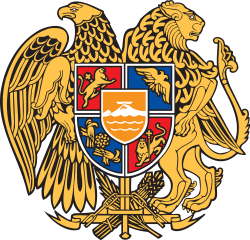Armenian Oblast
Coordinates: 41°N 44°E / 41°N 44°E
| Armenian Oblast (English) Армянская область (Modern Russian) Армянская область (Pre-1918 Russian) | |
|---|---|
 | |
| Established | 1828 |
| Abolished | 1840 |
| Political status Region |
Oblast Caucasus |
| Area | |
| Area - Rank |
27,830 verst² n/a |
| Population (1832 census) | |
| Population - Rank - Density - Urban - Rural |
164,500 inhabitants n/a 5.9 inhab. / verst² n/a n/a |
| Government | |
| First Head Last Head | n/a n/a |
The Armenian Oblast or Armenian Province (Armenian: Հայկական մարզ, Russian: Армянская область) was an oblast (province) of the Russian Empire that existed from 1828 to 1840. It roughly corresponded to most of present-day central Armenia, the Iğdır Province of present-day Turkey, and present-day Nakhchivan Autonomous Republic, an exclave of Azerbaijan. It was created out of the territories of the former Erivan and Nakhichevan khanates, which were ceded to Russia by the Persian Empire under the Treaty of Turkmenchay after the Russo-Persian War of 1826-1828. Ivan Paskevich, the Ukrainian-born military leader, was made count of the oblast in the year of its creation.
Demography and background
The Russian authorities allowed and encouraged Armenians living in Turkish and Persian territory to migrate into Russian territory – about 49,000 subsequently settled in the Armenian Oblast. Armenian captives who were moved and lived in Iran since 1804 or even as far back as 1795 were permitted to return,[1] which permitted Armenians to regain plurality. These policies contrasted with others imposed by the Russians, such as their attempt to replace the Catholicos at Echmiadzin, the offer to resettle Ganjevi Armenians in Georgia, or the removal of 250 Armenian families from Karabagh by a Russian detachment shortly after the fall of Ganjeh.[2] Muslims, referred to as Tatars, constituted the majority of the oblast's population, while Armenians formed the largest minority. It also had significant Georgian and Kurdish minorities.
Aftermath
In 1840 the Oblast was dissolved and its territory incorporated into a larger new province, the Georgia-Imeretia Governorate ("Gruzia-Imeretia"). This new division did not last long – in 1844 the Caucasus Viceroyalty was re-established, in which the former Armenian Oblast formed part of a subdivision named the Tiflis Governorate. In 1849 the Erivan Governorate was established, separate from the Tiflis Governorate. It included the territory of the former Yerevan and Nakhchivan khanates.[3]
See also
References
- ↑ The Cambridge History of Iran by William Bayne Fisher, Peter Avery, Ilya Gershevitch, Gavin Hambly, Charles Melville, Cambridge University Press, 1991 p. 339
- ↑ Russia & Iran 1780-1828 CB, by Muriel Atkin, University of Minnesota Press (1980) p. 85
- ↑ Hewsen, Robert H. Armenia: a Historical Atlas. Chicago, IL: University of Chicago Press, 2001, p173.
